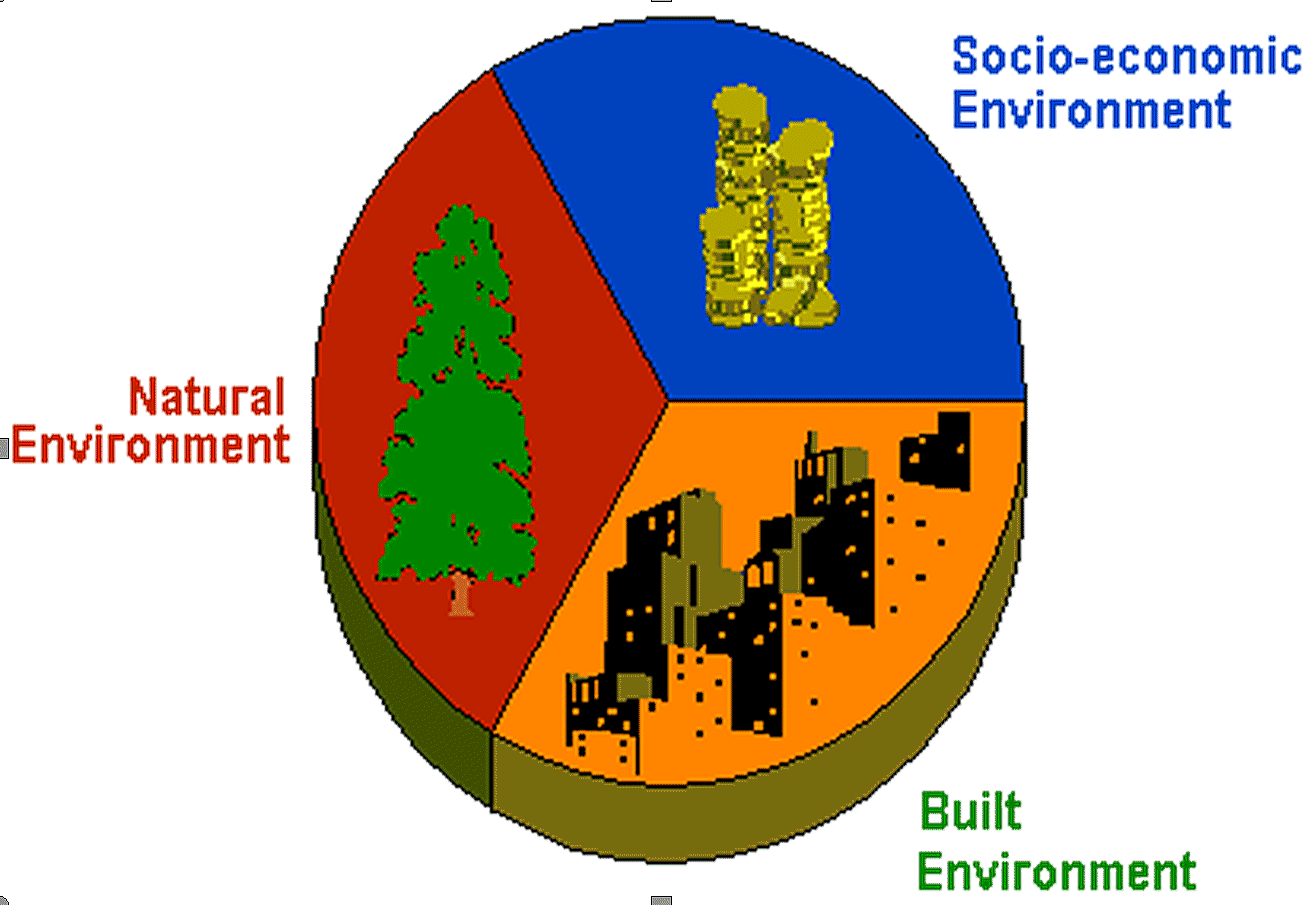|
Issues for Urban Environmental Management |
|||||||||||||||||||||||||||||||||||||||||||||||||||||||||||||||||||||||||||||||||||||||
Environment as the Common Denominator
The concern and problems associated with the environment have placed such issues high on the agenda of many bilateral and multilateral meetings. The Earth Summit of 1992 in Rio de Janeiro managed to highlight and channel efforts in understanding and acting on environmental problems, making it a key issue to be tackled in trade and commerce, in economic and social development, and in science and technology. Subsequent summits and congresses the Social Summit and the Beijing Conference on Women in 1995, the City Summit/Habitat II in 1996, not to mention innumerable regional, national and local meetings all had the larger global environment as a key common denominator in its action plans. It is only in the last few decades that a better understanding of the effects of changing environments and ecosystems has been developed. Interconnectedness of these factors has forced particular attention on human lifestyles and living conditions that has a profound effect on its surroundings. Most, if not all, environmental problems that we currently face can be directly or indirectly traced back to the legacy of lifestyles that we are inheriting and leading as human beings. Nowhere is this more true that in concentrations of gregarious urban lifestyles that are becoming the option of choice for the majority of humanity. The Master Culprit: Urban Environments Urban lifestyles and consumption patterns have far-reaching and long-term effects not only on its immediate boundaries, but also on the entire region in which it is positioned. Cities and towns in most countries around the world have been gaining considerable attention due to the large number of households migrating to cities and its consequent effects. It has also been due to the centrality of goods and services that cities offer, emerging over the last few decades as the major form of settlement. By the turn of this century, we will be witness to a ubiquitous scenario where more people will live in and around cities than in rural areas.
The result of this has been the explosive growth of urban areas, bringing with it a host of negative effects. Population concentration in increasingly smaller land masses has caused a drastic decline in the quality of living both in the residential and work fronts. Cities have, in effect, become a barometer of humankind's progress into the 21st century, whether this is an upward or downward trend. Such a scenario has had ripple effects on a variety of sectors such as education, health, labour/job markets, and economic activities. The growth and effect of an urban area should be seen not only in terms of its immediate boundaries, but also in terms of the resources necessary to sustain its population. An illustrative example is that of the Greater London area. The land mass that generates the resources necessary to sustain the population of London, called the 'urban footprint,' is actually slightly less than the entire land area of UK! This illustrates the complex interrelationship and interdependence of urban areas and their surrounding hinterland. Similarly, according to the Earth Council's report, "Ecological Footprints of Nations" Japanese lifestyles generate a demand for 6.25 hectare per capita (for resources such as energy, arable land, pasture, forest, built-up area, etc.). But the supply has been only 1.88 hectare per capita. This leaves a 'ecological deficit' of 4.37 hectare per person that has to be met from outside the country. The conurban region of Tokyo had a 1995 population of 26.8 million. For Tokyo alone, this ecological deficit is equal to 116,242,000 hectare or 3.07 times the total land area of Japan. This becomes 9.2 times the land area of Japan if only habitable land is taken into account (excluding mountains, water bodies etc.) The effects of urban activities have in many cases outweighed the relative advantages of agglomeration and centrality that they have offered. Thus, along with the benefits of urbanization come environmental and social ills, including lack of access to drinking water and sanitation services, pollution and carbon emissions etc. A wide variety of urban problems can be observed, grouped under two broad contradictive classes, those associated with poverty and those associated with economic growth and affluence. Environmental Management of Cities The World Resources Institute's report, "World Resources 1996-1997" focussed on urban environments. In its executive summary, the report paints a grim picture of urban environments - " ... Burgeoning cities are expanding into fragile ecosystems ... Cities sometimes deplete nearby areas of water and firewood, rendering them less capable of supporting rural populations and thus adding to the pressures for urban migration. Air pollution already exceeds health standards in many megacities in developing countries. Sewage and industrial effluents are released into water-ways with minimal or no treatment, threatening human health and aquatic life. Some urban environmental problems such as access to safe drinking water improve with economic growth, while others tend to worsen. Thus in the absence of policy reform, stronger institutions, and enlightened political leadership, economic and population growth in developing countries in the near term may lead to a deterioration of the urban environment, both physical and social. Stresses on the global environment from urban activities are also likely to accelerate. A major share of greenhouse gas emissions already comes from the use of fossil fuels in wealthy urban areas, especially in the developed countries." While laws exist to effect interaction and participation between the various actors involved in urban growth processes, it is not adequately exercised both on the part of local governments (sufficient information was not provided), as well as other actors and citizens themselves (there was no commitment to participate). Information that is shared by the government is, in many cases, partial or selective. There has, however, been a growing awareness of environmental problems and its causes and effects. With a gradual increase in the transparency and openness in the functional organization and operation of local governments, legislation on information disclosure has been receiving considerable importance. Basic understanding of environmental management of cities and the consequent needs of information for decision making processes has also improved. Community involvement becomes all the more critical when the shortcomings and weaknesses of local governments to effectively deal with the range of problems are taken into account. All this has necessitated a hard rethinking and reexamination of the intrinsic and symbiotic (negative and positive) relationships between human lifestyles and natural resources that is depended upon.
 Figure 1: The Three Dimensons of Urban Environments It is helpful therefore, to look at urban environments from three view points: the natural environment, the built environment and the socio-economic environment. Natural environments are essentially resources, processes and effects related to flora and fauna, human beings, minerals, water, land, air, etc. Built environments are resources, processes and effects related to buildings, housing, roads, railways, electricity, water supply, gas etc. The socio-economic environment includes resources, processes and effects related to human activities, education, health, arts and culture, economic and business activities, heritage - urban lifestyles in general. It is the intersection and overlay of these three dimensions that constitutes an 'urban environment'. Taking any one dimension at the exclusion of the other two, poses the inevitable danger of missing the forest for the trees - the interdependency and interdisciplinarity of the three dimensions have to be fully understood in the development of coherent and sustainable policies and programmes for the urban environment. This is particularly true with the multiplicity of actors and activities - there has been a growing realization that state agencies and activities are, but one part of a spectrum of agencies and activities that are involved in the urban environment. Interaction between the different actors at different levels of urban growth processes and cycles becomes critical to respond to the increasingly complex policy and investment choices that urban communities face. There are many key points that arise in support of a sound urban environmental policy. The concept of sustainable development ought to take into account the needs of future generations in decisions on how and whether to use resources and apply technologies, through policies, investments and development plans. Looking at Cities as Ecosystems A clear urban environmental policy framework should be delineated, based on natural ecosystems at national, regional and local levels, as well as on human-environment interactions. It should take into account the stresses and effects occurring within the urban arena. A system of prioritization has to be put in place, which incorporates human life, health, depletion and productivity of resource stocks, capacity of the environment, and systematic accounting measures.
Consolidating the ideas and issues together is the ecosystem approach. An urban ecosystem brings together the resources, processes and products into a coherent system that exchanges and makes use of byproducts and/or energy - aiming towards the reduction in the use of virgin materials as resource inputs; reduction in pollution; increased energy efficiency leading to reduced energy use in the system as a whole; reduction in the volume of waste products requiring disposal (with the added benefit of preventing disposal-related pollution); and increase in the amount and types of process outputs that have market value.
A city must have adequate infrastructure and flexibility to support the needs of its population, and the needs of the ecosystem as a whole. As in the case of the global system as a whole, cities must not use resources faster than they can be replenished or substituted for, nor generate pollution faster than it can be assimilated. One of the guiding principles for the future will be to reform urban systems so that they mimic the metabolism of nature. Rather than devouring water, food, energy, and processed goods, and then belching out the remains as pollutants, the city could align its consumption with realistic needs, produce more of its own food and energy, and put much more of its waste to use. Looking at cities as sustainable ecosystems draws its inspiration from the cyclical ecosystems of nature itself. It is sensitive to global impacts of local consumption and production patterns, and takes an interdisciplinary and interlinked approach in developing its activities, outputs and partners.
Developing cities as sustainable ecosystems requires a radical increase in the productivity of the resources it uses, and the goods and services it produces. This entails changes in both production, design and technology stretch the utility value of energy, minerals, water, and other natural resources. Closed-loop systems return every output harmlessly back to the ecosystem, or become an input to another process. This requires consumption and production systems that are modeled after the cyclical ecosystems of nature itself. This clearly needs an objective, multidisciplinary study of urban and economic systems and their linkages with fundamental natural systems. Research on energy supply and use, new materials, new technologies and technological systems, and other relevant issues is critical for a better understanding of the issues involved. In a broader sense, the ecosystem approach should be applied at all levels of resource consumption in a city - from building design and construction and its use, to macro scale issues of urban planning and development, urban management, network and social infrastructure (roads, electricity, gas, telecommunications, schools, hospitals etc.). The urban ecosystem approach raises several critical needs:
1. Ecological footprints of cities needs to be identified
2. Global trends to develop local environment activities
4. In-depth and intensive scientific research is needed
5. Existing environmental management functions and actions need to be integrated Ultimately, there is a need to create an impetus for change and to guide and direct that change to achieve real, demonstrable results. This will clearly require action to create/build a commitment to the pursuit of the sustainability concept, and then move towards creating a creating an organization with a shared commitment to the pursuit of shared goals. These two fundamental steps are necessary to generate broad support, external and internal, to the pursuit of sustainable objectives . This document is an updated version of a earlier paper written by the author at the International Environmental Technology Center, when managing the "Cities as Sustainable Ecosystems" project.
|
|||||||||||||||||||||||||||||||||||||||||||||||||||||||||||||||||||||||||||||||||||||||
 'Environment' means different things to different people. For some, it means separating the garbage into burnable and non-burnable items. To others it means saving on electricity or using less water. The term 'environment' may be associated with restoring the vitality of tropical rain forests, maintaining biodiversity and arresting desertification. Developing healthy, sustainable and safe communities becomes important to yet others. The environment also means agricultural and industrial production that is sound and 'green'. Some associate man-made chemical and nuclear hazards with concrete environmental policies. All of these views are right in their own way, and are united in its concern for the cyclical effects that the environment has on the day-to-day lives of current and future generations, and vice versa.
'Environment' means different things to different people. For some, it means separating the garbage into burnable and non-burnable items. To others it means saving on electricity or using less water. The term 'environment' may be associated with restoring the vitality of tropical rain forests, maintaining biodiversity and arresting desertification. Developing healthy, sustainable and safe communities becomes important to yet others. The environment also means agricultural and industrial production that is sound and 'green'. Some associate man-made chemical and nuclear hazards with concrete environmental policies. All of these views are right in their own way, and are united in its concern for the cyclical effects that the environment has on the day-to-day lives of current and future generations, and vice versa.

